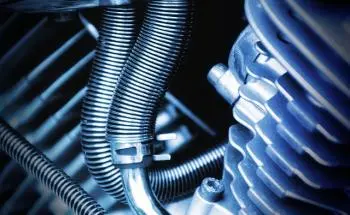
Thermodynamics is a fundamental branch of physics that focuses on the study of energy transformations in physical systems. This discipline has a wide range of applications in everyday life and science.
In this article, we will describe some concrete examples of thermodynamics that illustrate its importance in various contexts.
Example 1: Operation of a refrigerator
The operation of a refrigerator is a classic example of thermodynamics. The refrigerator uses the compression refrigeration cycle to keep food fresh.
In this process, a refrigerant circulates through a closed circuit, going through a series of stages that involve compression, condensation, expansion and evaporation.
-
Compression: The refrigerant is compressed in a compressor, which increases its pressure and temperature. This stage requires the input of energy in the form of work.
-
Condensation: Hot refrigerant is released into a coil located at the back of the refrigerator. Here, it gives off heat to the surroundings, condenses and becomes liquid.
-
Expansion: The liquid refrigerant expands through an expansion valve, which decreases its pressure and temperature.
-
Evaporation: The refrigerant enters the freezer compartment and absorbs heat from the food, evaporating and returning to a low temperature gas.
This cycle is constantly repeated, keeping the temperature inside the refrigerator at a lower level than the ambient temperature. Thermodynamics allows us to analyze and design efficient refrigeration systems.
Example 2: Internal combustion engine
Internal combustion engines, such as those used in automobiles, motorcycles, and machines, are another notable example of thermodynamics in action. These engines convert the chemical energy contained in the fuel into mechanical work. The thermodynamic cycle in an internal combustion engine consists of four stages: intake, compression, combustion and exhaust.
-
Intake: The engine draws in air and fuel through an intake valve.
-
Compression: The piston compresses the air-fuel mixture in the cylinder, which increases its temperature and pressure.
-
Combustion: A spark ignites in the spark plug, causing a chemical reaction that releases a large amount of energy in the form of heat. This heat increases the pressure and temperature of the gas in the cylinder, which pushes the piston down.
-
Exhaust: An exhaust valve opens and the burned gases are expelled from the cylinder.
This cycle repeats in each cylinder of the engine, converting chemical energy into mechanical work to propel the vehicle. Thermodynamics is fundamental to the design and optimization of internal combustion engines.
Example 3: Generation of electrical energy in thermal power plants
The generation of electrical energy in thermal power plants is another important example of thermodynamics in everyday life. These plants use thermal energy to convert it into mechanical energy and, finally, electricity. The process involves several stages:
-
Heat generation: A fuel, such as coal, natural gas or oil, is burned in a boiler. The heat generated increases the temperature of the water and converts it to steam.
-
Mechanical power generation: Water vapor is used to spin a turbine connected to an electrical generator. The expansion of steam through the turbine generates mechanical energy.
-
Generation of electrical energy: Mechanical energy is converted into electrical energy in the generator, which produces electrical current.
This process is efficient to the extent that it takes advantage of the conversion of thermal energy into mechanical energy and, finally, into electricity. Thermodynamics is crucial to understand and improve the efficiency of these plants.
Example 4: Oven operation
Ovens, both those used in the kitchen and industrial ones, are based on thermodynamic principles to operate. An oven heats a closed space to cook food or carry out industrial processes.
-
Heat generation: Whether through electrical resistance or the combustion of a fuel, the oven generates heat.
-
Heat Transfer: Heat is transferred through radiation, convection and conduction into the oven, heating food or materials.
-
Temperature Control: A thermostat maintains the desired temperature in the oven by adjusting the amount of heat provided.
Ovens use thermodynamics to ensure that the desired temperature is reached and maintained efficiently and accurately.
Example 5: Solar thermal energy
The generation of electrical energy from solar thermal energy is a relevant example of thermodynamics in the context of renewable energies.
Solar thermal systems use mirrors or lenses to concentrate solar radiation to a focal point, where a thermal fluid, such as oil or molten salt, is heated.
-
Solar energy absorption: Mirrors or lenses concentrate solar radiation on a receiver, heating the thermal fluid.
-
Heat transfer: Hot thermal fluid is used to generate steam, which in turn drives a turbine connected to an electrical generator.
-
Electrical power generation: The expansion of steam through the turbine converts mechanical energy into electricity.
Thermodynamics is applied here to understand the efficiency of converting solar energy into electricity and optimize energy harvesting.